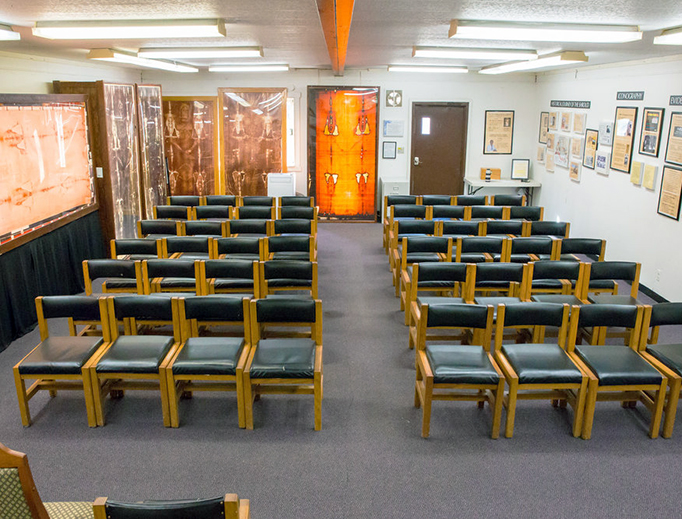Telling the Story of the Shroud of Turin
“We emphasize that while many in our generation believe that science and faith are contradictory, they, in fact, are not.”

Lee Sweeney is director of the Shroud Center of Southern California (https://www.shroudcenter.com/ or https://santiagoretreatcenter.org/shroud-center/). The Center was founded in 1996 by Dr. August Accetta to tell the story of the Shroud of Turin, which many believe to be the burial cloth of Christ. The Center is currently housed in the Santiago Retreat Center in Silverado, California, and welcomes visitors free of charge. Sweeney recently spoke about the work of the Shroud Center.
What do visitors see at the Shroud Center?
We have full-size replicas of the shroud, which measures about 14 feet in length by 3½ feet wide. It is an exact replica of the original you’d see in Turin, Italy. However, at the Center you can see more detail, as it is backlit in a light box and is at eye level. We have both the positive and negative images.
When you view the shroud in the negative, you can see what amounts to a three-dimensional image. The first negative image was seen in 1898 [taken by photographer Secondo Pia] and was previously unknown. It is really quite amazing.
We also have a 360-degree representation of all the major scientific studies that have been done on the shroud. It is the single most studied artifact in all of human history. We have them in sequential order, fully explained, and visitors can get the answers to many of the questions they might have.
We have information, for example, on the 1988 carbon dating study that supposedly showed that the shroud was a painting from the Middle Ages, sometime between 1200 and 1350. It caused many people to lose interest in it. However, further science showed that the carbon dating had been compromised, taken from an area of the shroud that was known to be a medieval side strip, added to the shroud so it could be hung up.
We have information on newer studies of textiles, which show that the shroud is similar to cloths from the first century Masada [an ancient Jewish fortress in Israel around the time of Christ], having a similar weave to those of the Masada. We have information on pollen studies, which show traces on the shroud of plants which would have been found in Jerusalem at Christ’s time.
What are some points that you try to emphasize to visitors?
We emphasize that while many in our generation believe that science and faith are contradictory, they, in fact, are not. Science points to faith. The prominent priest-philosopher Jesuit Father Robert Spitzer, for example, is on our Shroud Center board of directors. He has devoted much of his career to demonstrating the harmony between science and faith. He has a special interest in the shroud because it is wonderful evidence of the intersection of harmony and faith.
Young people come to us looking for answers. They want the truth. Many are rejecting faith because of the false belief that science has disproven faith. But seeing and experiencing the shroud is something that can really open their eyes to a new way of thinking.
How does the shroud affect you personally?
I was raised Catholic but became a militant atheist while in the university system. I came back to God, though, and have always had an interest in evidence for faith.
Professionally I was involved in technology, but I also have a background in art history. When I first got involved with the Shroud Center in 2000, it was mostly because I thought it was a historical curiosity.
But in recent years, I’ve come to believe that the natural explanations for the shroud have been disproven. So, we’re only left with one conclusion: that it is authentic and it is miraculous. It is also a primary piece of scientific evidence for the passion as a historical event, and the resurrection as well.
What plans do you have for the Shroud Center?
We want to establish a quarterly series where we bring shroud experts for presentations at Christ Cathedral, which is the mother church of the Diocese of Orange in California, where we’re located. We just had an event featuring Ian Wilson, a shroud expert, Dr. Accetta and Fr. Spitzer.
We’re also looking at creating educational videos for our website. We’ve been in discussions with the people at Prager University, which is known for its short videos on current cultural and political issues. We’d like to do something similar relating to the shroud. We believe that short videos with good graphics is an excellent way to relay information to the general public today.
And, we’re certainly going to continue to welcome visitors and introduce them to the shroud, which we refer to as the single most studied artifact in all of human history.
To visit the Shroud Center, or for more information, contact Lee Sweeney, (714) 342-1881 or [email protected].











